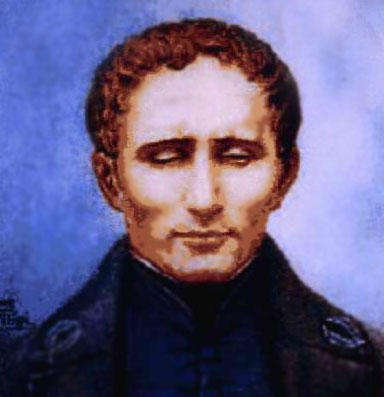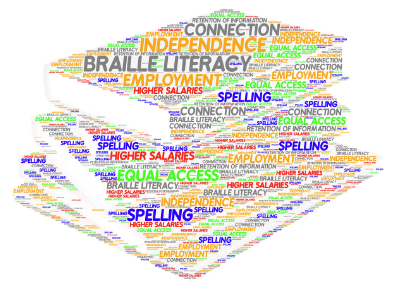Braille Literacy

“Braille is knowledge and knowledge is power.”
- Louis Braille
Braille Literacy - The Why
Braille is literacy for students who would otherwise be auditory learners. For those students, braille is the only way they can learn the fundamentals of spelling, grammar, and punctuation. Listening only is notably different from reading as it does not allow the person to know how every word is spelled or how sentences are structured. These elements are not part of the audio experience and are critical in becoming literate. In addition, braille outweighs audio formats as it aids comprehension and retention of materials.

Students who know Braille have greater independence. Braille can be used to:
- label food, medicine, or household objects.
- read a menu at a restaurant
- take notes
- identify and push the button on elevators
- and more!
Braille provides a connection to others and to self. The ability to take and share notes with others provides an avenue unmatched by the spoken word. With Braille, an individual can make a to-do list that can be reviewed at a later point in time.
For students who are at risk of losing vision suddenly or who have a progressive vision condition, braille gives a child options to use either print or braille in any given situation. These students should learn braille as soon as possible to provide them with an alternate means of communication. While they may not use braille right away, they have a tool tucked into their back pocket. Relearning braille when needed is easier. And, the educational system is much more supportive than adult programs where time is limited.
Content adapted from Braille Works
STAAR Braille Accommodations and Supports
Braille versions of the State of Texas Assessments of Academic Readiness (STAAR®) in English are available to eligible students. Students have the option to take STAAR online using a screen reader and a refreshable braille display. This option is only available on English versions of STAAR grades 3–8 reading, grade 8 social studies, English I, English II, and U.S. History. The decision to provide a student with a braille test booklet or access to an online test using a screen reader and refreshable braille display should be made in accordance with specific accommodation policies located on the Accommodation Resources webpage. It is recommended that the teacher of students with visual impairments be involved in that decision.
Additional information from the Texas Education Agency STAAR Accommodation Resources page.
Braille Challenge
The Braille Challenge® is an academic competition unlike any other. This two-stage contest is designed to motivate blind students to emphasize their study of braille while rewarding their success with fun-filled, but challenging, local and national events. Braille Challenge contest categories include reading comprehension, writing speed and accuracy, proofreading, spelling, and reading tactile charts and graphs.
Any visually impaired student who reads braille is eligible to participate in the preliminary Braille Challenge events, which are held from January through the end of March throughout the U.S. and Canada. Contests are proctored by volunteer TVIs and scored locally by volunteer transcribers, based on national guidelines. The preliminary round is open to students of all skill levels, but only the top-scoring 50 contestants nationally are invited to Los Angeles for the final round—two days of competition, camaraderie, and fun!
Region 10 hosts a Braille Challenge Biannually in Odd Numbered Years. For more information about Braille Challenge, see the Braille Challenge website of the Braille Institute.
Texas Technology Access Program (TTAP)
The Texas Technology Access Program (TTAP) promotes independence for people with disabilities through access to technology that provides them more control over their immediate environments and an enhanced ability to function independently.
The mission is to increase access for people with disabilities to Assistive Technology that provides them more control over their immediate environments and an enhanced ability to function independently.
TTAP Supports include:
- Demonstrations – See technology in action to determine what product is useful for you! Contact Shelley Ratcliff or Dr. Jyutika Mehta for more information.
- Device Loans - Short-term device loans are available for 35 days. When individuals with disabilities, their families, and qualified professionals are able to borrow AT devices and assess them in the individual's normal environments, they are then better able to determine if the devices meet their needs or the needs of individuals with disabilities they are serving.
- Recycle and Reuse Programs – Purchase refurbished equipment or a computer with long-term loans! TTAP works in partnership with the DME Exchange of Dallas to serve the North Texas area.
Other Braille Resources
- The History of Braille
- Introduction to Braille
- American Foundation for the Blind - Resources for Learning and Refreshing Braille
- American Foundation for the Blind - Sources for Braille Children’s Books and Magazines
- American Foundation for the Blind - Tips for Promoting Braille in the Classroom
- American Foundation for the Blind - Resources for Teaching Braille
 Program Coordinator
Program Coordinator Consultant
Consultant Administrative Assistant
Administrative Assistant